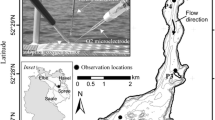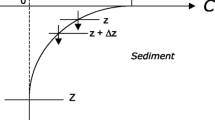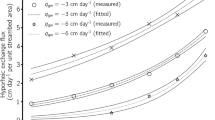Abstract.
The redox processes as well as the establishment of lateral redox sequences along a flowpath were investigated in column experiments containing natural sediments from a sand aquifer. While the concentration of the reducing agent acetate was held constant, the flow velocity was varied from 0.21 to 0.46 and 0.82 m/day. The redox processes were quantified by applying a numerical model that combines transport and reaction. Oxygen, manganese and ironminerals, and sulfate were reduced, before bacterial fermentation led to the production of methane. We observed that these redox processes all took place within the first 6 to 7 cm of the column length. The microbial decomposition rates increased proportionally with increasing flow velocities, resulting in a local establishment of a redox sequence.
Similar content being viewed by others
Author information
Authors and Affiliations
Additional information
Electronic Publication
Rights and permissions
About this article
Cite this article
Schlieker, .M., Schüring, .J., Hencke, .J. et al. The influence of advective transport on redox fronts in column experiments and their numeric modelling (part 1): the influence of variable flow velocities on turnover rates of primary redox processes. Env Geol 40, 1353–1361 (2001). https://doi.org/10.1007/s002540100378
Received:
Accepted:
Issue Date:
DOI: https://doi.org/10.1007/s002540100378




